
16 Objects — 4 C’s Divisions
Only one can be CHAMPION!



Toilet Seat Guitar, Mel Hummitzsch Clown Band, 1950-2002 (#4769.4)
This toilet seat guitar was definitely the quietest instrument in Mel Hummitzsch’s Clown Band, but it also might have been one of the more entertaining. The guitar was just one of Mel’s personal specialty instruments, alongside a bass drum and whistle. The entire band also included two trumpets, trombones, a saxophone and a snare drum. In 2008, Mel’s widow Loretta donated his beloved instruments to the Museum, along with his iconic clown uniform from the band.
Mel Hummitzsch was already a well-known area entertainer when he established his clown band around 1950. Featuring a variety of instruments and antics, the group regularly performed at county fairs, fire department events, and local parades. The band was also a popular feature of the Kohler Christmas Party for the children of employees. The band was only one aspect of his career – he worked with his father at Art & Mel Hummitzsch General Contractors Inc, building countless structures throughout the county and he also operated Mel Hummitzsch Theatrical Agency, Inc., booking countless acts across six Midwest states.


Kidillac, Garton Toy Company, circa 1950 (#4726.21)
It was no surprise when the Kidillac won our first Museum Madness Tournament in 2021!
Perhaps Garton’s most famous and best loved pedal car, the Kidillac, was designed to be a miniature replica of the real thing. The company employed one of the designers of the original Cadillac in creating the “streamline, 1950 design, built low for ease of propulsion… made of one-piece steel, no seams or joints to come apart,” which could be customized to match the family car. Like their other pedal cars, the Kidillac featured the quality details that Garton was known for — numbered license plates, detailed instrument panels, rubber wheels and more. This particular Kidillac was one enjoyed by the Garton family for generations.
Established in 1879 as the Garton Company, the firm initially produced common utilitarian products, including cigar boxes and washboards. By the early 1900s, Garton had transitioned into wheeled riding toys, establishing an impressive network of distribution centers and showrooms across the country. Sales offices in New York, Chicago, Dallas, and Los Angeles, alongside a program of national catalog sales, supported the growing business as the company expanded into sleds, wagons, croquet sets, water skis, and toy cradles. The expanding market, coupled with Garton’s attention to changing styles and designs as the century progressed, made the company a leading producer of pedal toys for over 75 years.

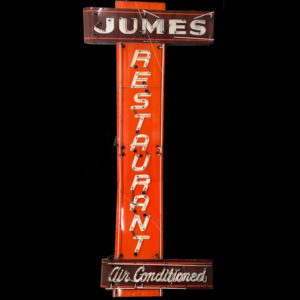
Neon Sign, Jumes Restaurant, 1955-2016 (#5378.1)
While the Kidillac tried to defend the title, the Jumes Restaurant Neon Sign stole the show during the 2022 Museum Madness Tournament.
Through the generosity of Patrick Ortlieb of Ortlieb Commercial, the new owner of the building, and RLO Sign, the iconic Jumes Restaurant sign arrived at the Museum in June 2016. One of the largest single free standing objects in the collection, the neon sign hung outside Jumes Restaurant for generations. In June 1951, the city issued a permit to Coney Island Lunch Counter for a projecting sign. The sign was originally installed in the summer of 1951 as the restaurant prepared to open in their new location, just south of the original restaurant. The neon sign features prominently in August 1951 advertisements for the Grand Opening of the new location, though the top reads “Coney Island.” The advertisement also credits Norman Thiex, Inc. of Sheboygan for manufacturing the sign.
Jumes Restaurant, as it came to be known by 1955, began with George Jumes purchase of Sheboygan’s Coney Island Lunch Counter in October 1929. Jumes, who originally emigrated with his parents in 1902 from Greece, had just returned to Sheboygan after spending a number of years in La Crosse. George operated Coney Island Lunch at the original location until moving just a little south near the corner of Eighth Street and Pennsylvania Avenue. All the members of the family worked in the restaurant and eventually George’s son, Louis took over the restaurant. Although Jumes suffered a devastating fire in 1990, the restaurant was able to reopen after nearly a year rebuilding. Unfortunately, the return was short-lived, as the economic downturn following September 11, 2001 was more than the restaurant could survive. The final Coney Dogs were served in 2003.
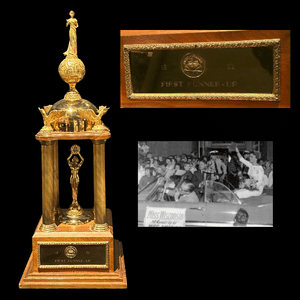
Miss America Runner-Up Trophy, Mary Alice Fox, 1959 (#3685)
Winning Miss Sheboygan Jaycee in 1957 set Mary Alice Fox on an exciting adventure nearly two years later when she qualified to compete in the Miss Wisconsin Pageant. Her comedy act, along with her intelligence and personality, helped her to win the Miss Wisconsin 1959 title, providing not only a shot at becoming MIss America, but also a one-thousand dollar scholarship, eight piece sterling silver set, gasoline for a 1959 Nash Rambler used for official appearances, and personalized wardrobe. In early September, Fox set out for Atlantic City to compete against fifty-three other women. After a competition filled week in which Fox was praised for her comedy sketch during the talent portion and won a preliminary swimsuit round, Mary Alice Fox was ultimately named First Runner Up in the pageant. Forty years later, she graciously donated both trophies from her wins to the Historical Society.
Born in Sheboygan to Dr. Harry and Mrs. Alice Fox, Mary Alice graduated from Sheboygan Central High School in 1957. After spending two years at Valparaiso University in Indiana, Fox had plans to return to Wisconsin in Fall 1959 and enroll at the University of Wisconsin – Madison to pursue an education in speech therapy when the chance to compete for Miss Wisconsin came. In the year following, Fox made countless appearances and married fellow Sheboyganite Alton Schmitt. The couple relocated to Los Angeles, where Alton worked as a nuclear engineer. When interviewed in 2009, Mary Alice remarked “I’ve never thought of myself as a celebrity. The Miss America contest was just a fun time for me and for Sheboygan.”

Plymouth Rocker, Plymouth Chair Company, 1908-1919 (#5481.1)
While rocking chairs were part of the product line of many Sheboygan County furniture manufacturers, one company in particular specialized in the style. The Plymouth Rocker was a prominent line for the Plymouth Chair Company and widely marketed throughout the country. This armless rocking chair was the first example of the company’s chairs for the Museum’s collection. Though missing the paper tag indicating the model number, the colorful general label on the seat underside identified the maker.
In 1902, Plymouth Chair Company developed out of changes with the Schram-Huson Chair Company. The factory, located on Western Avenue, incorporated a play on the popular Plymouth Rocker chicken breed as part of their marketing. Their rockers gained a positive reputation and in 1906, employees of the company sent a Plymouth Rocker to Alice Roosevelt as a wedding gift. Following a number of ownership changes in the late 1910s, the company filed for a name change to Crescent Chair Company in late 1919.

Cord-marked Pot, Middle-Late Woodland or Oneota, BC 300 - AD 1500 (#4725)
The presence of pottery in local Native American settlements marked a transition to a new lifestyle for the area’s earliest residents. This cord-marked pot is among the numerous pieces of tempered pottery found by brothers Alphonse, Jacob and John Gerend. Typically tempered with either rock or shell, the pottery provided superior food storage and cooking vessels for both Oneota and Woodland cultures as they adopted more agrarian lifestyles. Pieces such as these can date as early as 500 BC and many included some type of decorative pattern, including those seen here.
The Gerend brothers were among numerous collectors of Native American artifacts in Sheboygan County in the late 1800s and early 1900s. Both John and Jacob were part of the family’s furniture and funeral businesses, working as cabinetmakers and undertakers. Dr. Alphonse Gerend, perhaps the best well known in archaeological circles, pursued a medical career while also dedicating his life to learning about the Native American cultures of both the Sheboygan County area and the state. He published numerous accounts of his research, especially as a member of the Wisconsin Archaeological Society. He also spent many vacations at the reservations of the Potawatomi and Ho-Chunk. Much of the work he did is now held at Milwaukee Public Museum and the Wisconsin Historical Society as well, including a significant photography collection.

Whale Vertebra, Unknown (#420)
When Anton Opgenorth discovered a large bone while digging post-holes on his farmland, the Sheboygan Press quickly noted the discovery, noting that it “leads to the belief that in prehistoric days mastodons were in this region.” The bone was soon donated to the Historical Society and for many years, it was as close as the Historical Society came to having dinosaur bones (a common question of the average elementary school student). In the early 1990s, suspicions arose that perhaps it wasn’t really from a mastodon.
Following a consultation with experts at Milwaukee Public Museum, a new story developed. Likely from one of the 5 large whale species, an outside possibility existed that the vertebra could have been deposited years ago during another age when whales may have been as far inland as what we think of as the Great Lakes. The more likely story though was the vertebra being carried into the area, based on the perfectly sawed off spines. Perhaps used as a stool or a footrest, it was eventually cast off by the original owner. Since the Opgenorth farm was eventually developed into The River portion of Kohler’s Blackwolf Run Golf Course and no additional bones were found, the latter is probably a more likely story.
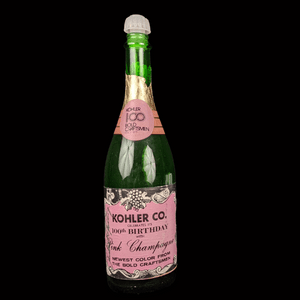
Commemorative Centennial Champagne, Kohler Company, 1973 (#4963.1)
In preparation for the company’s 100th Anniversary, Kohler Company developed a novel commemorative product. Having introduced a rainbow of plumbing fixture shades like Blueberry Citron, Tiger Lily, and Avocado beginning in 1965 under the tagline The Bold Look of Kohler, the company celebrated their centennial with a fitting color addition – Pink Champagne. Not only was the new color featured in the Centennial Home, built as a showcase home in the village, but it was also featured on bottles served at the company’s annual employee picnics. Many were signed by Herbert Kohler, Jr., who had just recently risen to the position of Chief Executive Officer.
Founded in 1873 by John Michael Kohler and Charles Silberzahn, primarily manufactured plows and other agricultural implements. Following a fire, the company moved to a new facility and added a enameling shop, expanded their product line to include water troughs, cast iron benches, and enameled containers. Over the next one hundred years, Kohler continued to innovate and expand, adding plumbing fixtures, generators, and world class destination experiences. As the company prepares to celebrate their 150th Anniversary in 2023, they are even bringing back two heritage colors of the past – 1972 Spring Green and 1934 Peachblow.
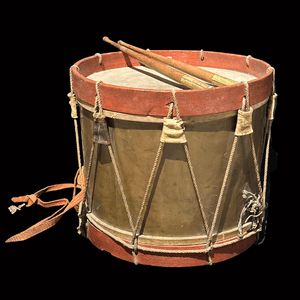
Handmade Snare Drum, Louis C. Meyer, 1870-1910 (#1081)
Donated by Eitel Meyer, this drum was said to be handmade in 1870 by the donor’s father Louis C. Meyer. Louis was said to use it marching up and down 8th Street in Sheboygan to arouse the volunteer fire department. First started in 1848, the Sheboygan Fire Department remained a volunteer organization for nearly 30 years. Despite that, the City Council approved payment of $8.00 to each volunteer fireman in 1869, likely paving the way for the establishment of a paid department, which began in 1875.
Born in Lippe-Detmold, Germany, Louis Meyer likely came to Sheboygan during the late 1840s or 1850s. When he passed away in 1918, the second paragraph of his obituary alluded to his musical talents – that he “served nine years in the German army as a drummer” and “Old residents of the city recall that Mr. Meyer played the reveille on the morning of every Fourth of July up to about six years ago.”

Drivers Education Car Sign, Oostburg High School/ AAA, circa 1965 (4907.1)
Beginning in 1950, Oostburg High School, along with several other area schools began offering driver’s education as part of the high school curriculum. In Oostburg, it was offered as part of the district’s Freshman Citizenship class. For numerous years, the school offered only classroom instruction, until a behind-the-wheel component was added. This Driver’s Education sign could be easily strapped to the roof of any vehicle. Donated by local collector Scott Lewandowske, the sign was left behind at an Oostburg Ford dealership when the business closed.
Behind the wheel training for driving may seem a rite of passage in today’s world, but there was a time where it was a minor part of the licensing process. For many communities, driver’s education took off in the years after World War II, primarily with classroom courses offered through high schools. In Sheboygan County, the local branch of AAA was a driving force behind the addition of behind-the-wheel training. During a 1954 school board meeting, the local AAA representative shared the “merits of inclusion of practice driving as a laboratory phase of classroom instruction.” Within a few years, such training took hold in the larger county districts and by the mid-1960s, was offered regularly at most area high schools.

Painting, Headwater of the Milwaukee River, circa 1850 (#942)
While we know today that the main headwater of the Milwaukee River originates in Fond du Lac County, two of the three branches traverse Sheboygan County. The north branch of the river begins just outside of Cascade while the east branch winds in and out of Sheboygan County along the western border with Fond du Lac County. This painting likely depicts the origin of the North Branch, based on the information provided when the painting was donated in 1956. Genevieve Richardson recounted the piece depicted the “source of Milwaukee River which is in Sheboygan County, c 1850” and had hung in the home of her grandfather, David Giddings.
Mr. Giddings arrived in Sheboygan County in 1837 as he worked to document land across the Wisconsin Territory. He decided to make the area his home, purchasing land in what is today Sheboygan Falls and establishing a thriving sawmill, in addition to building a successful farm. Giddings undertook a successful political career, serving for a time as County Judge, along with serving in the House of Representatives for the Wisconsin Territory. He also was a part of drafting the state constitution.

Commemorative Centennial Plate, St. Thomas Lutheran Church, Waldo, 1968 (#2876)
Among the most popular commemorative items for anniversaries, commemorative plates are a common object created for celebrations. Donated in 1990, this plate celebrating the Centennial of St. Thomas Lutheran Church in Waldo is among numerous examples of plates in the Museum’s collection that celebrate the anniversaries of area communities, businesses, churches, and civic groups. The plates often have a familiar format, with an image on the front, along with the celebratory information, while the back typically features a brief historical account. This plate was among the numerous Centennial undertakings of the congregation.
St. Thomas Lutheran in Waldo was initially known as St. Luke’s. The original church, built in 1868, was served by itinerant pastors until 1885 when the Reverend John Herzer began serving them on a regular basis. Over the coming years, numerous pastors ministered to the congregation. The church built a new building, the one featured on the plate, in 1951. The church’s 100th anniversary was celebrated throughout 1968 with a variety of activities in addition to the commemorative plate, including special services, a dinner, vow renewal activities and reunions. At the time of the Centennial, there were 210 members. The church remains active today.
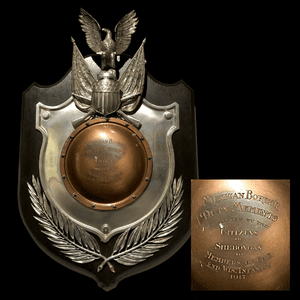
Mexican Border Duty Trophy, Wisconsin National Guard Company C, 2nd Infantry, 1917 (#TBD)
This sizable (and heavy!) trophy was given to members of Wisconsin National Guard’s Company C, 2nd Infantry, upon their return from service in 1917. Following a deadly raid into New Mexico by Mexico’s Francisco “Pancho” Villa, President Woodrow Wilson mobilized the entire U.S. National Guard in response to a quickly escalating situation. From June 1916 to March 1917, the Company marched, guarded, fortified, and fought mock battles. Area citizens raised money to present service members with individual medals alongside this trophy during a celebratory banquet held upon their return in March 1917. We know that the trophy had arrived at the Museum by the early 1970s, but no record of the donation has been found.
The establishment of Sheboygan’s Company C dates back to the days of the Civil War. A Company C populated with numerous Sheboygan County residents had served during the war, but was disbanded shortly after. However, in the wake of the war, shooting clubs began springing up across the country and in 1869, the Evergreen City Cadets organized in Sheboygan. By 1870, the group was a formal volunteer militia associated with the City of Sheboygan. When the National Guard was established in 1882, they were renamed Company C, 2nd Infantry of the Wisconsin National Guard. The Company served in numerous conflicts, including the Spanish-American War and World War I, in addition to their service along the border in 1916-1917.

Schoenhut Santa Figure, H.C. Prange Company, 1921-1990 (#2725)
Before the popular mechanical animation of later years, the H.C. Prange Company ordered a special object to feature in their 1921 Christmas window display. “Santa-in-a-Sleigh” was offered by the A. Schoenhut Company on a made to order basis. Following the holiday season, the set was given to the Revered Emil F. Mueller of the German Baptist Church in Sheboygan. Donated to the museum in 1989, Santa and his reindeer have changed little, with only Santa’s suit and shoes replaced in the last 85 years. This Santa was the inspiration for the Museum’s annual holiday display, which began in 1990. Much like Prange’s, Holiday Memories actually started off without any of the beloved mechanical window animation.
The A. Schoenhut Company began in Philadelphia in 1872. Eventually known as the Schoenhut Piano Company, the business was the first to export their products to Germany. In the early 1900s, the company added the Schoenhut Art Doll, a spring jointed doll made entirely of wood. The dolls were among the first to be able to be posed or set into stands. Like many companies across the country, the Great Depression took a toll on the organization and the business closed in 1935. Since that time, Schoenhut dolls have often been popular collectibles.

Armadillo Promotional, Leverenz Shoe Company, circa 1976 (#5073.14)
After years of specializing in dress shoes for men, Sheboygan’s Leverenz shoe company expanded into the casual market with the introduction of the Armadillo. When the new design, featuring a semi-circular stitch over the top, reminded some of an armadillo shell, the name stuck and launched a nationwide marketing campaign. Sheboygan’s Jacobson Rost Advertising suggested a real armadillo as part of the Leverenz trade show display. After arriving in Wisconsin, ‘Big Tex’ learned he wouldn’t be welcome as an exhibitor, so a stand-in was developed. However, the shoe and campaign were successful. The line expanded within the year to include a version for women and within two years, the company was celebrating the 500,000th pair of Armadillos.
Established in April 1919, the Leverenz Shoe Company was one of the primary shoe manufacturers in Sheboygan County throughout the twentieth century. The building and machinery of the Twig Shoe Company were purchased by Clarence Leverenz as he entered into a partnership Henry and Otto Jung of the Jung Shoe Company and R. Ackermann. The majority of Leverenz’s business was in the men’s dress shoe market, with fashionable shoes under the Calumet, Kushion Kings, and Morgan Quinn brand names. Despite efforts to modernize, the influx of inexpensive imported shoes wiped out the domestic footwear business and Leverenz closed in 1989.

Business Sign, A.P. Lyman General Store, 1847 - circa 1860 (#1056)
Years after it was likely taken down, the wooden sign that had graced one of Asahel Lyman’s storefronts was donated to the Historical Society by Mrs. Mabel North, whose husband William was the grand-nephew of Lyman. The couple had lived for years at the home built by Lyman on Pennsylvania Avenue years before. The sign likely hung at Lyman’s storefront that had been located a few miles east of the homestead on Pennsylvania Avenue between 7th and 8th Streets. Built in 1847, the Penn Avenue store was the primary receiving and distribution center for an impressive mid-1800s network of stores. Advertisements in issues of The Sheboygan Mercury from 1851 and 1852 proclaimed “Good News and True!” that great bargains were available at Lyman’s Sheboygan store.
Asahel P. Lyman, along with his brother George, established a booming commercial enterprise in the early years of Sheboygan County. After moving from New York in 1845, George first opened a store in Sheboygan Falls. Asahel joined his brother a year later and the two were able to open branch stores in Sheboygan, Fond du Lac, Calumet and Berlin. In time, Asahel turned his focus to transportation, leaving the retail business and underwriting the construction of numerous ships. Likewise, he supported the need for rail service to the area and the building of the plank road between Sheboygan and Fond du Lac.
